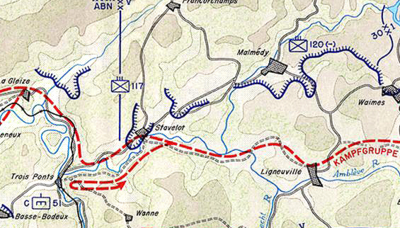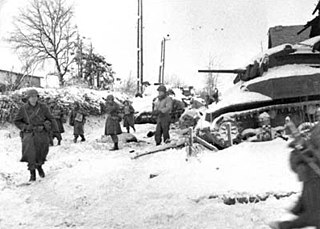
The Battle of the Bulge, also known as the Ardennes Offensive, was the last major German offensive campaign on the Western Front during World War II. The battle lasted for five weeks from 16 December 1944 to 28 January 1945, towards the end of the war in Europe. It was launched through the densely forested Ardennes region between Belgium and Luxembourg. It overlapped with the Alsace Offensive, subsequently the Colmar Pocket, another series of battles launched by the Germans in support of the Ardennes thrust.

The Malmedy massacre was a German war crime committed by soldiers of the Waffen-SS on 17 December 1944 at the Baugnez crossroads near the city of Malmedy, Belgium, during the Battle of the Bulge. Soldiers of Kampfgruppe Peiper summarily killed eighty-four U.S. Army prisoners of war (POWs) who had surrendered after a brief battle. The Waffen-SS soldiers had grouped the U.S. POWs in a farmer's field, where they used machine guns to shoot and kill the grouped POWs; the prisoners of war who survived the gunfire of the massacre then were killed with a coup de grâce gun-shot to the head.

Joachim Peiper was a German Schutzstaffel (SS) officer and a Nazi war criminal convicted for the Malmedy massacre of U.S. Army prisoners of war (POWs). During the Second World War in Europe, Peiper served as personal adjutant to Heinrich Himmler, leader of the SS, and as a tank commander in the Waffen-SS.

The Malmedy massacre trial was held in May–July 1946 in the former Dachau concentration camp to try the German Waffen-SS soldiers accused of the Malmedy massacre of 17 December 1944. The highest-ranking defendant was the former Waffen-SS general Sepp Dietrich.

The siege of Bastogne was an engagement in December 1944 between American and German forces at the Belgian town of Bastogne, as part of the larger Battle of the Bulge. The goal of the German offensive was the harbor at Antwerp. In order to reach it before the Allies could regroup and bring their superior air power to bear, German mechanized forces had to seize the roadways through eastern Belgium. Because all seven main roads in the densely wooded Ardennes highlands converged on Bastogne, just a few miles away from the border with neighboring Luxembourg, control of its crossroads was vital to the German attack. The siege was from 20 to 26 December, until the besieged American forces were relieved by elements of General George Patton's Third Army.

The 1st SS Panzer Division Leibstandarte SS Adolf Hitler or SS Division Leibstandarte, abbreviated as LSSAH, began as Adolf Hitler's personal bodyguard unit, responsible for guarding the Führer's person, offices, and residences. Initially the size of a regiment, the LSSAH eventually grew into an elite division-sized unit during World War II.

The Panzer-Lehr-Division was an elite German armoured division during World War II. It was formed in 1943 onwards from training and demonstration troops stationed in Germany, to provide additional armored strength for the anticipated Allied invasion of western Europe. On 4 April 1944, the division was officially designated as the 130th Panzer Division; however, it is usually referred to as the Lehr Division. It was the only Wehrmacht Panzer division to be fully equipped with tanks and with halftracks to transport its mechanized infantry. On several occasions it fought almost to destruction, in particular during Operation Cobra, and by the end of the war in Europe bore little resemblance to the unit that had originally been activated.

The I SS Panzer Corps was a German armoured corps of the Waffen-SS. It saw action on both the Western and Eastern Fronts during World War II.

The Battle of Losheim Gap was fought in the Ardennes, in Eastern Belgium, between the Allies and Nazi Germany, part of the Battle of the Bulge. It was the first battle and spearhead of the German attack, inflicting heavy American casualties, and causing disorder on the frontlines. It paved the way for further German attacks, deeper into the Ardennes. The Americans suffered high casualties, but could replace them. The Germans, on the other hand, couldn't replace their men, as all reserves were directed to the counter offensive. This reflected the poor state that the German Army was in at this time, which would be the precedent for the following battles.
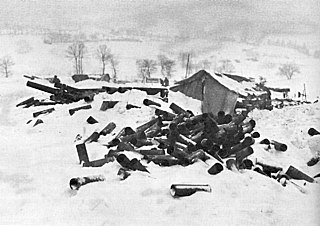
The Battle of Elsenborn Ridge refers to the northernmost German attacks during the Battle of the Bulge. The area from Elsenborn Ridge itself to Monschau was the only sector of the American front line attacked during the Battle of the Bulge where the Germans failed to advance. The battle centered on the boomerang-shaped Elsenborn Ridge east of Elsenborn, Belgium. In this region, Elsenborn Ridge marks the westernmost ridge of the Ardennes, rising more than 2,000 feet (600 m) above sea level; unlike the uplands further north, east and south, it has been extensively logged. West of Elsenborn Ridge, where the land descends in gentle hills to the cities of Liège and Spa, was a network of Allied supply bases and a well-developed road network. The Germans planned on using two key routes through the area to seize Antwerp and force a separate peace with the United States and Britain. Capturing Monschau, the nearby village of Höfen, and the twin villages of Rocherath-Krinkelt just east of Elsenborn Ridge, were key to the success of the German plans, and Hitler committed his best armored units to the area.

The 818th Tank Destroyer Battalion was a tank destroyer battalion of the United States Army active during World War II. It first saw combat in July 1944, when it deployed into the Normandy beachhead in preparation for the breakout into France by Lieutenant General George Patton's Third Army. Working closely with the 5th Infantry Division, it moved through northern France up to the Moselle region, where it was involved in the Battle for Metz through September, October and November. In December, it disengaged from defensive positions along the German border and was moved north to fight in the Battle of the Bulge with the 26th Infantry Division. After securing the Allied flanks and mopping up the Bulge, it refitted for two months before fighting south along the Siegfried Line and crossing the Rhine in March. In April and early May, it rushed through southern Germany into Austria and Czechoslovakia, where it ended the war. After a brief spell of occupation duties, it was returned to the United States and disbanded in November. During the European campaign, the battalion lost a total twenty-six men and eight tank destroyers in combat.
The 773rd Tank Destroyer Battalion was a tank destroyer battalion of the United States Army active during the Second World War.

The Battle of Lanzerath Ridge was fought on December 16, 1944, the first day of the Battle of the Bulge during World War II, near the village of Lanzerath, Belgium, along the key route for the German advance on the northern shoulder of the operation. The American force consisted of two squads totalling 18 men belonging to a reconnaissance platoon and four forward artillery observers, against a German battalion of about 500 paratroopers. During a day-long confrontation, the American defenders inflicted dozens of casualties on the Germans and delayed by almost 20 hours the advance of the entire 1st SS Panzer Division, the spearhead of the German 6th Panzer Army.

The 643rd Tank Destroyer Battalion was a tank destroyer battalion of the United States Army active during the Second World War.
Gustav Knittel was a mid-ranking commander in the SS Division Leibstandarte (LSSAH) who was awarded the Knight's Cross of the Iron Cross. Sentenced to life imprisonment for ordering the illegal executions of 8 American prisoners of war, he was released in 1953.
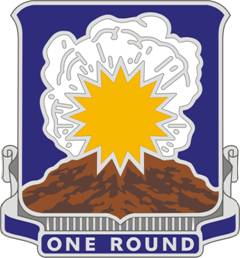
The 705th Tank Destroyer Battalion was a tank destroyer battalion of the United States Army active during the Second World War. It was originally formed from artillery elements of the 5th Armored Division, and its lineage is today perpetuated by the 75th Cavalry Regiment.

The 648th Tank Destroyer Battalion was a tank destroyer battalion of the United States Army active during the Second World War.
Operation Greif was a special operation commanded by Waffen-SS commando Otto Skorzeny during the Battle of the Bulge in World War II. The operation was the brainchild of Adolf Hitler, and its purpose was to capture one or more of the bridges over the Meuse river before they could be destroyed. German soldiers, wearing captured British and U.S. Army uniforms and using captured Allied vehicles, were to cause confusion in the rear of the Allied lines. A lack of vehicles, uniforms and equipment limited the operation and it never achieved its original aim of securing the Meuse bridges. Skorzeny's post-war trial set a precedent clarifying article 4 of the Geneva Convention: as the German soldiers removed the Allied uniforms before engaging in combat, they were not to be considered francs-tireurs.
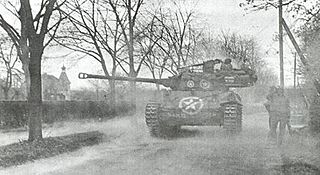
The 824th Tank Destroyer Battalion was a tank destroyer battalion of the United States Army active during the Second World War. It saw service during 1944–45 in the European Theater of Operations, primarily attached to the 100th Infantry Division in an infantry support role. After fighting through France and southern Germany, the battalion ended the war in Austria.
The 654th Tank Destroyer Battalion codename: Highroad was a tank destroyer battalion of the United States Army active during the Second World War. They landed at Omaha Beach on July 11, 1944. The Battalion was activated on 15 December 1941 at Fort Benning, Georgia.
